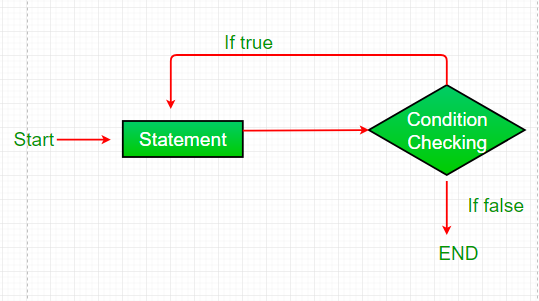Introduction to Do-While Loop in Java
The do-while loop in Java is a fundamental control structure that allows a code block to execute repeatedly based on a specified condition. Unlike other loops, the do-while loop guarantees at least one execution of the code block before the condition is checked, making it ideal for tasks like user input validation and menu-driven applications. Understanding the do-while loop is crucial for writing effective Java code, especially for developers working in Java programming or software development roles.
What is a Do-While Loop in Java?
The do-while loop structure guarantees that the enclosed code block will execute at least one time, regardless of the condition. This is beneficial in scenarios like menu-driven programs or user validation, where you need the loop to execute before checking any condition.
The syntax of a do-while loop:
do {
// Code block to execute at least once
} while (condition);
How the Do-While Loop Works in Java
In Java, the do-while loop:
- Executes the code inside the
doblock once. - Checks the condition after the first execution.
- Repeats the code block if the condition is
true; otherwise, it terminates.
Example Code for Do-While Loop in Java
Below is an example that demonstrates the do-while loop by printing numbers from 1 to 5:
public class DoWhileExample {
public static void main(String[] args) {
int i = 1;
do {
System.out.println("Number: " + i);
i++;
} while (i <= 5);
}
}Explanation: This loop will output numbers 1 to 5. Even if the condition is false initially, the code within the do block will still run once.
Practical Example of the Do-While Loop
A common example is to create a user authentication check that prompts until correct credentials are entered:
import java.util.Scanner;
public class LoginExample {
public static void main(String[] args) {
Scanner scanner = new Scanner(System.in);
String password;
do {
System.out.print("Enter your password: ");
password = scanner.nextLine();
} while (!password.equals("JavaRocks"));
System.out.println("Access granted!");
}
}
Use Cases for Do-While Loop in Java
- Input Validation: Prompt the user for input until valid data is entered.
- Menu-Driven Programs: Display a menu repeatedly until the user exits.
- Repeating Operations: Ensure a piece of code runs at least once, such as initializing values or generating outputs.
Best Practices for Using Do-While Loops
- Use only when a condition must be met post-execution:
do-whileis most effective for cases requiring at least one execution before the check. - Limit nested use: Using multiple
do-whileloops within each other can decrease readability. When necessary, add comments to clarify the loop’s purpose. - Optimize conditions: Avoid complex conditions inside
do-whileas they can complicate readability and troubleshooting.
Comparison with While Loop
The main difference between do-while and while loops is when the condition is evaluated:
- Do-While Loop: Executes once before the condition check, making it ideal for scenarios needing initial execution.
- While Loop: Checks the condition first, which means it may never execute if the condition is initially
false.
Common Interview Questions
Explain the purpose of a do-while loop in Java and provide a basic example.
A do-while loop in Java ensures the code block executes at least once, as the condition is checked after execution.
Companies: TCS, Infosys, Capgemini
How does a do-while loop differ from a while loop in Java?
Unlike a while loop, a do-while loop checks the condition after executing the loop body, so it always runs at least once.
Companies: Accenture, Wipro, Oracle
When would you prefer to use a do-while loop over a for or while loop?
Use a do-while loop when you need the loop to execute at least once, regardless of the condition.
Companies: Cognizant, JPMorgan Chase, IBM
What are some practical use cases for a do-while loop in programming?
A do-while loop is useful for menu-driven programs, input validation, and retrying user prompts.
Companies: Goldman Sachs, Amazon, Cisco
Write a program using a do-while loop to prompt user input until a valid entry is provided.
The program can prompt the user until they enter a specific or valid input, ensuring at least one prompt.
Companies: Microsoft, HCL, Google
Best Practices for Using Do-While Loops
- Use clear conditions: Ensure the condition aligns with your loop requirements to avoid infinite loops.
- Limit its use: Use do-while loops sparingly as they execute at least once, even if the condition is false.
- Control Iterations: Define loop exit points carefully to prevent unintentional, endless execution.
Summary
The do-while loop’s versatility makes it essential for scenarios where at least one iteration is necessary before evaluating conditions, providing a straightforward way to handle cases like input validation, retry mechanisms, and other iterative processes. Understanding when and where to use do-while loops can streamline code efficiency and improve control in your Java programs.
Advantages and Disadvantages of Do-While Loop
- Advantages:
- Executes at least once, which is useful for prompts and validation checks.
- Simple and clear for cases needing initial execution.
- Disadvantages:
- Can lead to errors if the initial execution isn’t intended.
- Not always ideal for complex conditions or when minimal control is required over iterations.
Additional Resources
To learn more about loops, check out:
JAVA : Java API Documentation
Conclusion
The do-while loop is a valuable tool in Java, especially when initial execution of code is required. By understanding the do-while loop and its proper use cases, you can write cleaner, more effective code that handles various user interaction scenarios smoothly.
Do While Loop
The do-while loop in Java is a control structure that executes a block of code at least once before checking a specified condition. The syntax includes a do keyword followed by the code block, and the while keyword with the condition at the end. If the condition evaluates to true, the loop repeats; if false, the loop terminates. This structure is useful in scenarios where an action must occur before validation, such as user input prompts or menu selections. Understanding the do-while loop is essential for effective programming in Java, ensuring code clarity and functionality.
Question
Your answer:
Correct answer:
Your Answers
